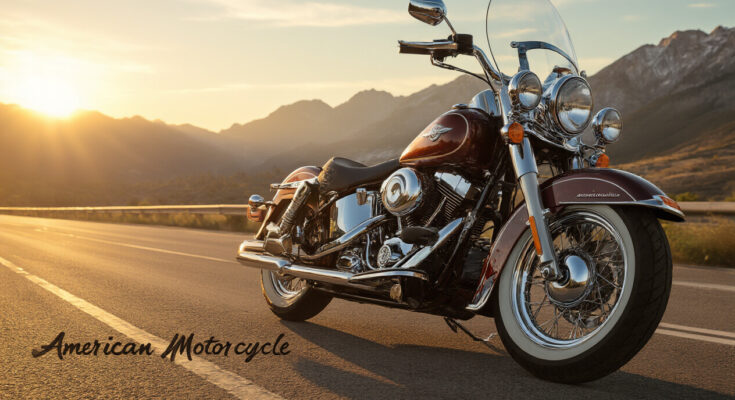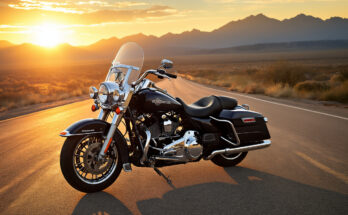Ever found yourself in a traffic jam, watching motorcycles effortlessly weave through cars while you sit there, going nowhere? Yeah, that envy hits different.
The American motorcycle scene isn’t just about transportation—it’s a lifestyle statement, a community, an obsession. For those ready to embrace the wind-in-your-face freedom, knowing which motorcycle brands dominate US roads can make all the difference.
From the rumbling American classics to sleek Japanese engineering, the most sought-after motorcycle brands today reflect both heritage and innovation. Riders aren’t just buying bikes; they’re buying into legacies and technological promises.
But here’s what most people get wrong: the “best” motorcycle brand isn’t universal—it depends entirely on what kind of rider you want to become. And that’s where things get interesting…
The American Motorcycle Renaissance
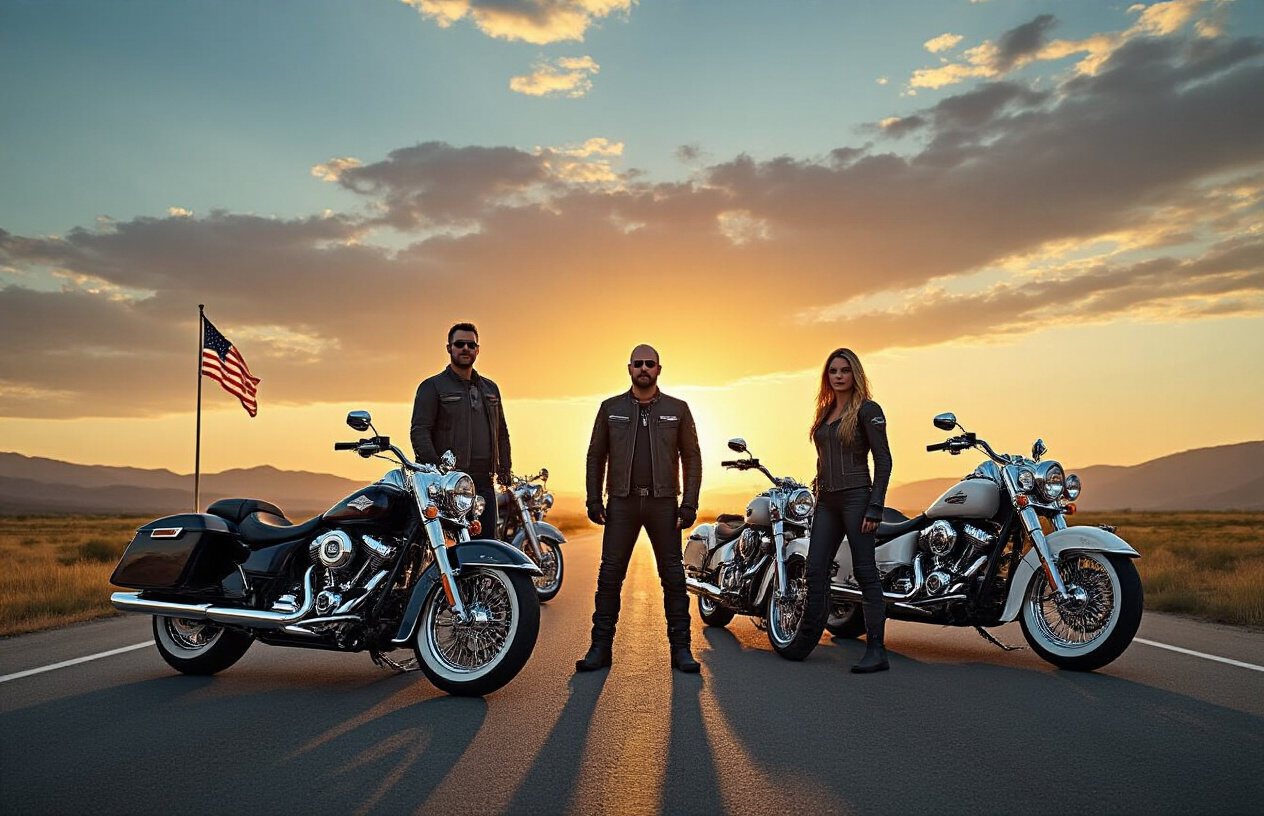
Why US motorcycles are experiencing a surge in popularity
American motorcycles aren’t just making a comeback – they’re roaring back with a vengeance. Riders across the country are trading in their foreign bikes for homegrown iron, and the numbers don’t lie. Harley-Davidson’s stock jumped 30% last year while Indian Motorcycle reported record sales.
What’s driving this shift? It’s pretty simple: nostalgia with a modern twist.
Riders crave that authentic American experience – the rumble, the style, the heritage. But now they’re getting it without the headaches that plagued older models.
Plus, let’s talk about patriotism. With manufacturing moving overseas, many riders are voting with their wallets, choosing to support American jobs and craftsmanship.
How American brands have evolved for modern riders
Gone are the days when American bikes meant gas-guzzling beasts that leaked oil on your garage floor.
Today’s American motorcycles blend that classic DNA with technology that actually works. Indian’s Ride Command system makes your smartphone look primitive, while Harley’s new Pan America adventure bike proves they can compete in any category.
The evolution isn’t just mechanical. These companies finally realized not everyone wants a chrome-laden cruiser. Now you’ll find American-made sport bikes, adventure tourers, and even electric motorcycles that’ll smoke most gas bikes off the line.
Key innovations driving domestic brand growth
The innovation revolution in American motorcycles breaks down into three game-changers:
- Performance tech that rivals anything from Japan or Europe
- Rider-focused features that make long trips actually comfortable
- Manufacturing processes that deliver better quality without astronomical prices
Electric powertrains represent the biggest leap. Zero Motorcycles builds bikes in California that deliver 140+ mile range and charging times under an hour. LiveWire (Harley’s electric brand) isn’t just competing – it’s setting standards.
Customization has also evolved beyond paint jobs. Modular design lets riders transform their bikes for different uses without special tools or mechanical skills.
Harley-Davidson: The Quintessential American Legend
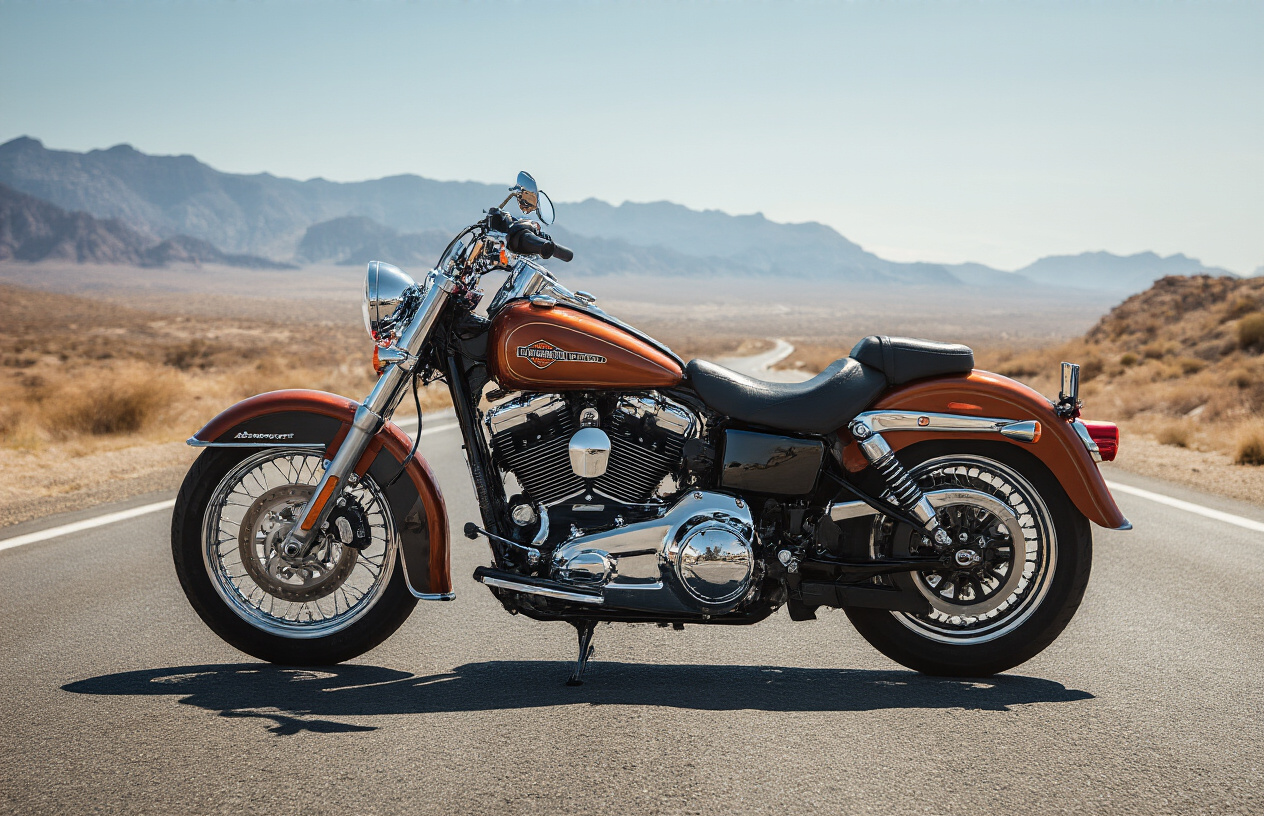
A. Latest models capturing riders’ imagination
Nothing turns heads quite like a Harley. The 2023 lineup proves why these machines still reign supreme on American highways. The Nightster stands out with its lightweight frame and that signature rumble that makes your chest vibrate. Then there’s the Street Glide ST—basically a two-wheeled muscle car that eats highways for breakfast.
But the real showstopper? The Low Rider ST. Harley took that classic SoCal style, beefed it up with the Milwaukee-Eight 117 engine, and created what might be the perfect blend of performance and attitude. Sales have gone through the roof, and waiting lists at dealerships don’t lie.
B. How the brand maintains its heritage while embracing innovation
Harley pulled off the impossible—they’ve modernized without selling their soul. The design team still hand-sketches concepts before touching a computer. The V-twin engine remains sacred, but now it’s paired with ride modes, traction control, and cornering ABS.
Their manufacturing still happens on American soil, but the factories look nothing like they did 20 years ago. Robots handle precision work while master technicians focus on the details that make each bike special.
The company listens to riders too. When die-hards complained about certain “improvements,” Harley backtracked and found better solutions. They’re not changing for change’s sake—they’re evolving with purpose.
C. The Pan America: Harley’s successful adventure into new territory
Nobody saw this coming. A Harley adventure bike? Yet the Pan America silenced critics faster than its 150-horsepower Revolution Max engine hits redline.
This machine doesn’t just compete with European and Japanese adventure bikes—it beats them at their own game. The adaptive ride height technology alone is revolutionary, automatically lowering the bike at stops so riders of all sizes feel confident.
Dealers report that 62% of Pan America buyers are new to the Harley brand. That’s not just a success—it’s a revolution in orange and black. The bike has won shootouts in magazines that historically favored imports, proving Harley can dominate beyond cruisers when they set their minds to it.
D. Why Harley owners remain the most brand-loyal in the industry
Harley doesn’t sell motorcycles—they sell membership cards. When you buy a Harley, you’re instantly part of something bigger.
The Harley Owners Group (H.O.G.) boasts over a million members worldwide. These aren’t casual riders; these are people who tattoo the bar and shield logo on their bodies. Try finding another motorcycle brand inspiring that level of commitment.
The community aspect is unmatched. Ride a Harley across the country and you’ll never be alone—other owners will stop to help you, share stories, or just give that knowing nod at stoplights.
And Harley supports this loyalty with lifetime service at any dealership, extensive customization options, and events that feel more like family reunions than marketing opportunities. They’ve mastered what other brands only dream about—turning customers into evangelists who wouldn’t dream of riding anything else.
Indian Motorcycle: The Historic Challenger
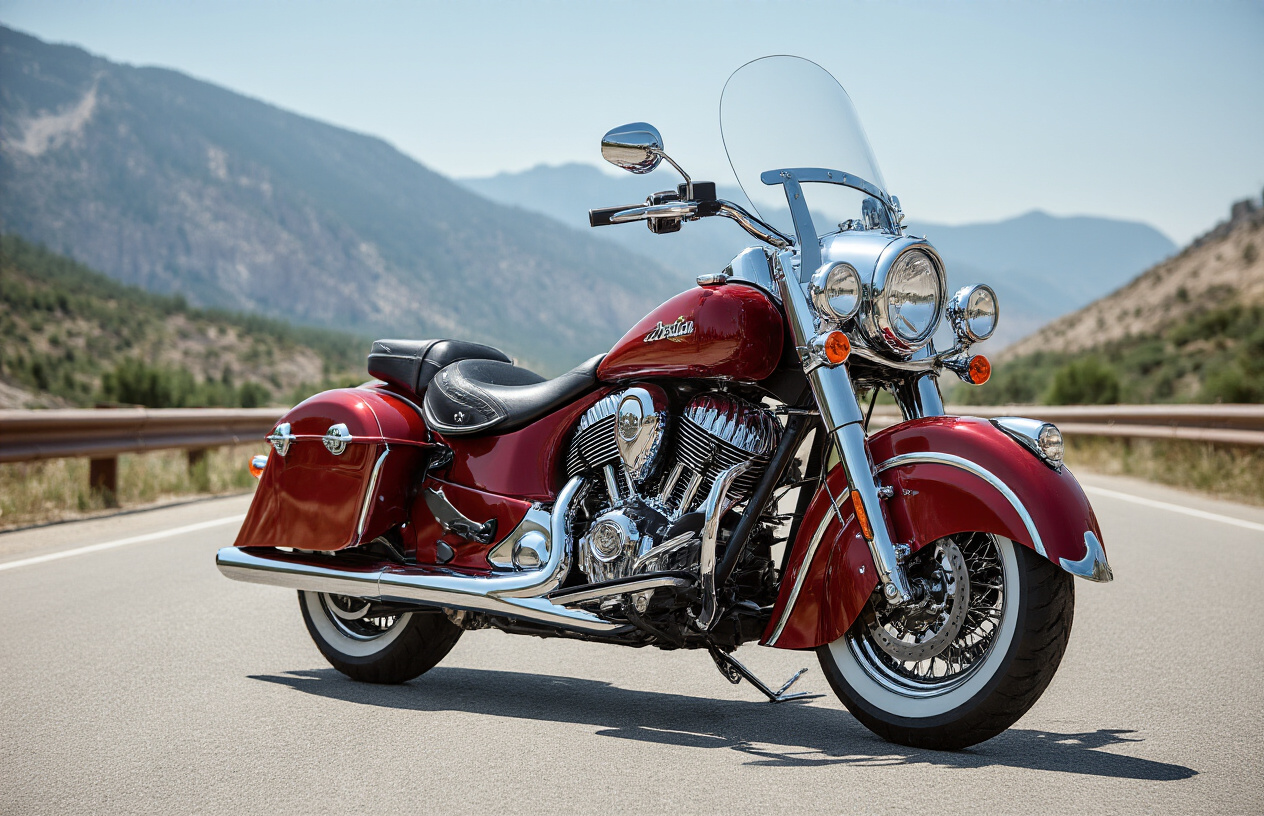
The remarkable comeback story
Indian Motorcycle isn’t just another bike brand – it’s America’s first motorcycle company, born in 1901. But man, what a rollercoaster ride they’ve had.
After dominating racing circuits in the early 1900s, Indian hit rock bottom in 1953 when they shut down completely. For nearly 60 years, this legendary name gathered dust while Harley enjoyed the spotlight alone.
Then 2011 happened. Polaris Industries swooped in, bought the brand, and kickstarted one of the most impressive comebacks in motorcycle history. They didn’t just slap the Indian logo on generic bikes – they rebuilt everything from scratch.
The 2014 Chief lineup changed the game. These weren’t knockoffs – they were engineering masterpieces with that thunderous Thunder Stroke 111 engine that made riders’ hearts skip a beat.
FTR series: changing perceptions of American motorcycles
American motorcycles had a reputation: big, heavy cruisers that dominate highways but struggle when roads get twisty.
The FTR 1200 blew that stereotype to pieces.
Based on Indian’s dominant flat track racing bikes, the FTR brought something completely fresh to the table – an American sport naked that could hang with the best from Europe and Japan.
With its upright riding position, 120 horsepower V-twin heart, and nimble handling, the FTR proved American bikes could carve corners with the best of them.
What’s really cool? The FTR doesn’t try to be Japanese or European. It keeps that raw American soul – just packaged in a completely new way.
How Indian differentiates from Harley-Davidson
Both companies wave the American flag proudly, but they’re as different as Yankees and Dodgers fans.
Indian embraces technology without hesitation. Ride modes, cornering ABS, fancy touchscreens – they’re all in. Harley has caught up recently, but Indian jumped in headfirst.
Their design philosophy differs too. While Harley often plays it safe with incremental changes to their classic look, Indian takes bigger swings. The FTR was a risk that paid off. The Scout Bobber pushed boundaries. The Challenger took the battle directly to Harley’s home turf.
Indian’s pricing strategy is also aggressive – often delivering more standard features at similar price points. They’re the hungrier competitor, constantly trying to prove themselves against the established king.
The result? Two distinct American motorcycle experiences that couldn’t be more different despite sharing the same homeland.
Victory & Buell: American Phoenixes
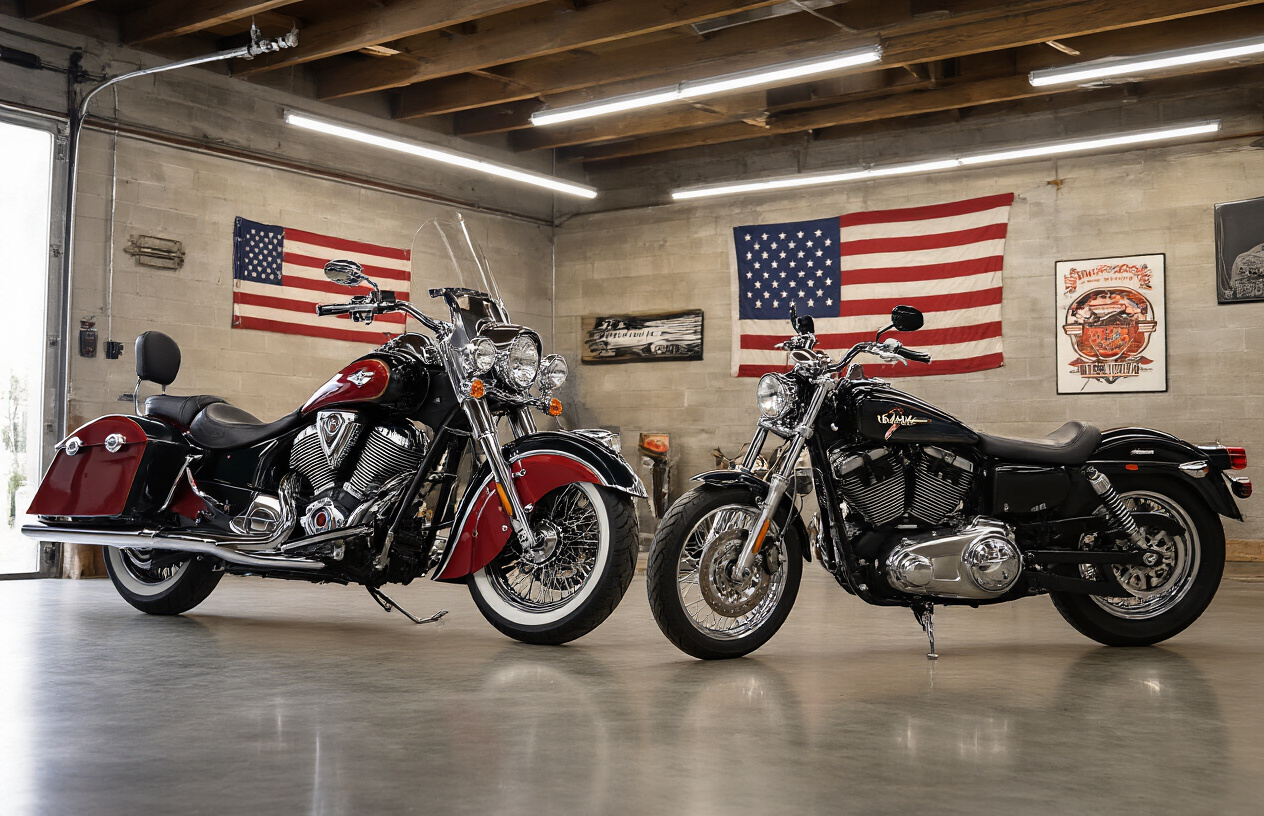
The resurrection of iconic American brands
Ever wondered what happens when legendary motorcycle brands refuse to stay dead? Victory and Buell are answering that question in style.
Victory’s comeback story is nothing short of remarkable. After Polaris pulled the plug in 2017, nobody saw the resurrection coming. But here we are, with Victory bikes back on American roads, sporting their distinctive angular styling and performance-focused engineering that always set them apart from the Harley crowd.
Buell’s journey is even wilder. Erik Buell’s passion project got swallowed up by Harley-Davidson, then unceremoniously dumped during the 2009 financial crisis. Now they’re back with a vengeance, still building those quirky, innovative bikes with perimeter brakes and fuel-in-frame designs that made gearheads swoon.
What’s new in their current lineups
Victory’s new machines keep their muscle bike DNA intact while embracing modern tech. The revamped Cross Country touring models feature upgraded navigation systems and rider ergonomics that make thousand-mile rides feel like a Sunday cruise. Their new electric prototype shows they’re not just reliving past glories.
Buell hasn’t missed a beat either. The Hammerhead 1190RX still delivers that insane 185 horsepower that’ll snap your neck back, but now with traction control systems that actually let you use all that power. Their SuperTouring model combines sportbike handling with long-distance comfort in a way only Buell could imagine.
Who these bikes appeal to today
Victory attracts riders who want American-made muscle without following the herd. These are the folks who appreciate engineering over image, performance over nostalgia.
Buell’s fanbase remains among the most devoted in motorcycling. They’re the thinking rider’s choice – engineers, tech professionals, and passionate enthusiasts who appreciate Buell’s unconventional problem-solving and handling that feels like nothing else on two wheels.
Both brands speak to riders who value the road less traveled. In a world of conformity, Victory and Buell owners are making statements about American innovation with every mile.
American Custom Culture
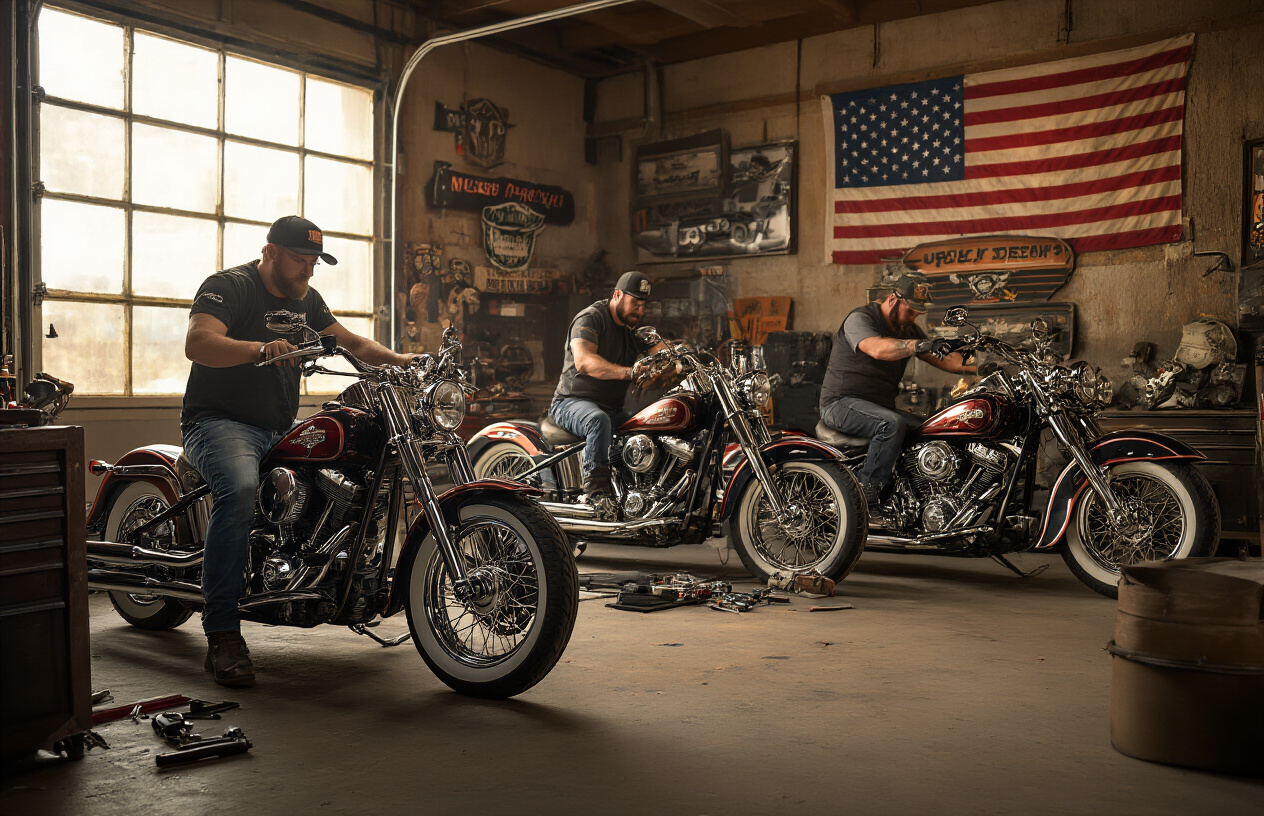
The enduring appeal of custom choppers
Nothing screams American motorcycle culture quite like a custom chopper rolling down the highway. These bikes aren’t just transportation—they’re rolling art pieces that capture our collective obsession with freedom and individuality.
Why do choppers still grab our attention decades after they first appeared? It’s simple: they break rules. While factory bikes play it safe, choppers push boundaries with their stretched-out forks, fat rear tires, and outrageous paint jobs that turn heads at every stoplight.
What started in garages after WWII has evolved into a cultural phenomenon. Veterans modified surplus military Harleys, stripping away unnecessary parts (“chopping”) to create lighter, more personalized rides. Today’s builders carry that tradition forward, even as their tools and techniques have advanced.
Leading custom builders shaping today’s trends
The custom scene thrives on innovation from builders who’ve become celebrities in their own right:
- Paul Yaffe creates bikes with impossibly clean lines and attention to detail that borders on obsessive
- Arlen Ness pioneered designs that influenced even major manufacturers
- Roland Sands blends racing DNA with street-worthy customs
- Revival Cycles pushes technical boundaries with museum-worthy creations
These visionaries don’t just build bikes—they create styles that ripple through the entire industry.
How factory customs compare to true one-offs
The major manufacturers noticed the appeal of custom bikes and responded with their own “factory customs.” These production bikes borrow custom styling cues while maintaining dealer networks and warranties.
True one-offs deliver something else entirely:
| Factory Customs | True Custom One-Offs |
|---|---|
| Mass-produced with “custom” aesthetics | Handbuilt from ground up |
| Limited customization options | Unlimited personalization |
| Dealer warranty protection | Builder reputation as guarantee |
| Predictable performance | Unique riding experience |
Factory customs offer accessibility, but nothing matches the soul of a bike built specifically for you.
The investment value of custom American motorcycles
Custom bikes aren’t just about looking cool—they can be surprisingly smart investments. Limited-production customs from renowned builders have appreciated dramatically, sometimes outperforming traditional investments.
Bikes from builders who’ve passed away or closed shop often see values skyrocket. Early customs by Indian Larry or Arlen Ness now command six-figure prices at auction.
But not all customs appreciate equally. The investment sweet spot combines:
- Exceptional craftsmanship
- Innovation that influenced the wider industry
- Documentation proving provenance
- Historical significance
The smartest collectors buy bikes they love first, with potential appreciation as a bonus. After all, you can’t ride a stock certificate on a summer evening.
Performance Comparisons That Matter

A. Power-to-weight ratios of leading American models
American muscle doesn’t just apply to cars. When you twist the throttle on a Harley-Davidson Fat Bob, you’re commanding 114 cubic inches of pure torque. But raw power isn’t everything.
The real magic happens in the power-to-weight department. Take Indian’s FTR 1200 – packing 120 horsepower into a 508-pound frame gives you that snap-your-neck acceleration that makes riding thrilling. Meanwhile, Victory’s legacy models still impress with their balanced approach.
Here’s how the numbers stack up:
| Motorcycle | Power (HP) | Weight (lbs) | Power-to-Weight |
|---|---|---|---|
| Indian FTR 1200 | 120 | 508 | 0.236 |
| Harley Street Rod | 70 | 505 | 0.139 |
| Motus MSTR | 180 | 565 | 0.318 |
| Zero SR/F | 110 | 485 | 0.227 |
The Motus MSTR? Absolute beast. Shame they stopped making them.
B. Handling characteristics that define American rides
American bikes corner differently. Period.
That long wheelbase on your Road King isn’t just for show – it delivers straight-line stability that makes highway cruising a dream. The trade-off? You’re not flicking through twisties like some Italian sport bike.
American engineers know their market. They’ve designed machines that plant themselves on the road, giving riders confidence in their ride’s predictability.
The new Indian Challenger breaks the mold though. Its aluminum frame and more aggressive geometry make it handle more like a sport-tourer than a traditional cruiser. The low center of gravity across most American rides means they feel more planted than their weight would suggest.
C. Technology integration in modern American motorcycles
Gone are the days when American bikes meant mechanical simplicity and nothing else.
Have you seen Harley’s new Boom! Box GTS infotainment system? Touch-sensitive even with gloves on. Indian’s Ride Command system gives you a 7-inch glove-compatible touchscreen with navigation that actually works.
American manufacturers finally understood that technology enhances the riding experience:
- Ride modes that adjust power delivery
- Cornering ABS that won’t let you wash out in a turn
- Traction control systems tuned specifically for V-twin torque curves
- Bluetooth connectivity for everything from music to phone calls
What’s impressive is how they’ve integrated all this tech while maintaining that distinctive American feel. The soul remains intact.
D. Value propositions compared to European and Japanese competitors
The sticker shock is real. A fully-loaded CVO Road Glide will set you back over $40,000.
So why bother when you could get a fully-loaded Japanese tourer for $10K less?
American bikes hold their value better. Check out five-year depreciation numbers:
| Brand | Average 5-Year Depreciation |
|---|---|
| Harley-Davidson | 31% |
| Indian | 35% |
| Honda | 46% |
| BMW | 41% |
Then there’s the intangible value. The highway presence. The sound. The community.
Japanese bikes might give you more features per dollar initially, but they can’t deliver that distinctly American riding experience. European brands offer precision engineering but at premium prices that make Harleys look reasonable.
E. Long-distance comfort features that set American bikes apart
Crossing state lines on a motorcycle reveals its true comfort.
American tourers and cruisers excel here. The riding position – that relaxed, feet-forward stance – reduces back fatigue on those 500-mile days. The wider, more cushioned seats support your rear end for hours without complaint.
Premium models come with:
- Electronically adjustable suspension that reads the road
- Heated grips and seats for those chilly mountain passes
- Frame-mounted fairings that direct wind over you, not at you
- Infotainment systems that keep you connected and entertained
The Indian Roadmaster takes things further with its ClimaCommand seats that not only heat but actively cool on scorching summer rides.
These bikes were built for the vast American landscape, and it shows in every comfort feature they include.
Buying Guide: Finding Your Perfect American Ride
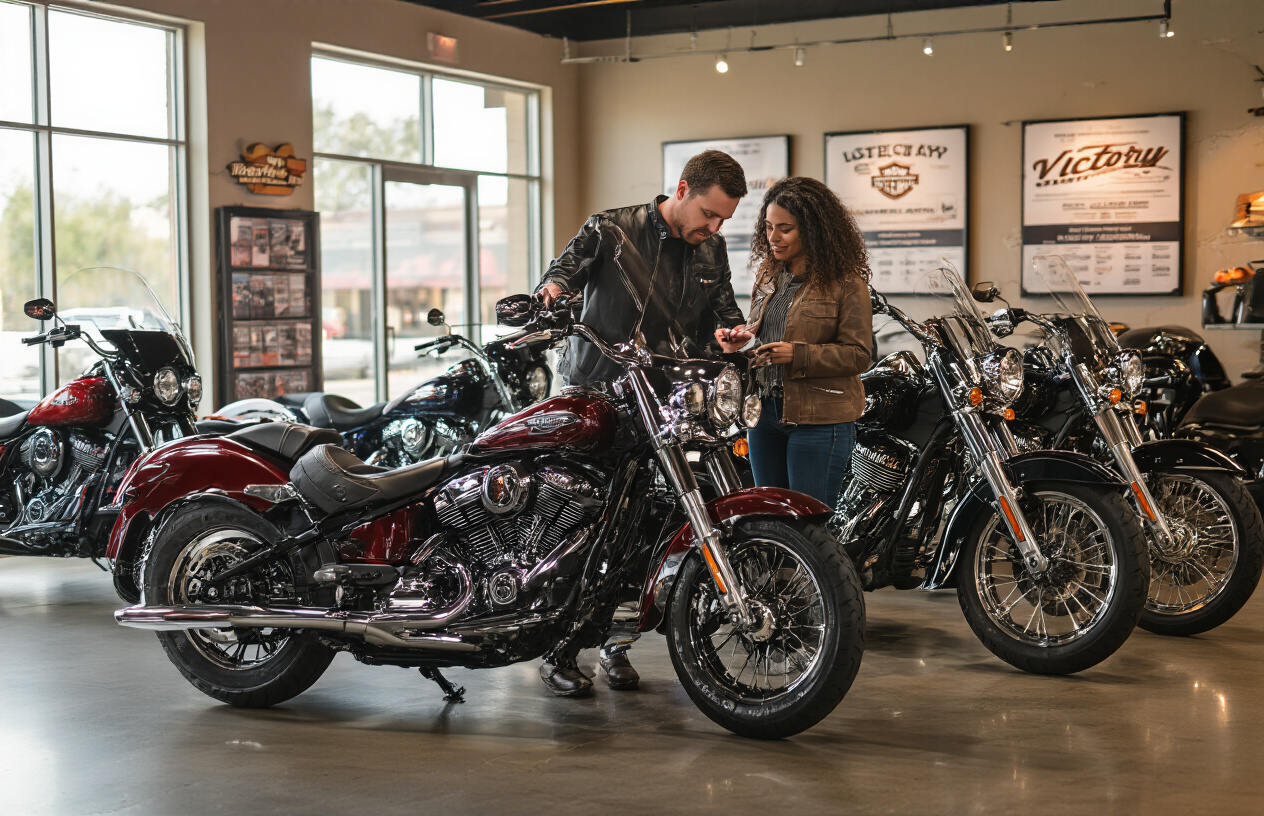
Matching riding style to the right American brand
You’re about to drop serious cash on an American motorcycle. But which one actually fits how you ride?
Harley-Davidson shines for cruising and touring. Their bikes are built for those long, straight highways where comfort matters more than cornering speed. If you love the rumble of a V-twin while crossing state lines, Harley’s your pick.
Indian Motorcycles offer similar cruising appeal but with a different flavor – smoother engines and more tech features baked in. Their Scout line works great for newer riders, while their heavyweight Chieftain models compete directly with Harley’s touring lineup.
Victory riders (though discontinued in 2017) still have a cult following for good reason – they deliver modern performance with classic American styling.
For something completely different, Motus makes sport-touring machines that can hang with European bikes on twisty roads. Their MST models pack serious punch for riders who want American-made but aren’t sold on the cruiser vibe.
New vs. used: where the best values lie
The sticker shock on new American motorcycles is real. We’re talking $15-30K for many models right out the door.
Used bikes? That’s where the smart money goes. American motorcycles typically lose 20-30% of their value in the first two years. But – unlike cars – they can run forever with proper maintenance.
Look for 2-4 year old bikes with under 15,000 miles. The previous owner ate the depreciation, but you’re getting essentially the same machine.
Exception: limited editions and certain classic models actually appreciate. A pristine 1969 Harley Electra Glide might cost more than your house.
One warning – avoid heavily modified bikes unless you’re comfortable dealing with potential gremlins. That chopped frame and custom exhaust might look cool, but factory specs exist for a reason.
Financing options specifically for American motorcycles
Financing an American motorcycle doesn’t have to mean selling a kidney. You’ve got options.
Manufacturer financing often beats bank rates. Harley-Davidson Financial Services regularly offers rates around 3.99% for qualified buyers, sometimes with zero down. Indian does similar promotions through their partners.
Credit unions consistently offer better rates than traditional banks for motorcycle loans. We’re talking 1-2% less in many cases. That adds up over a 60-month loan.
Another option? Many dealers offer in-house financing for buyers with challenged credit. The rates aren’t pretty (think 12-18%), but it gets you riding while rebuilding your credit.
Pro tip: always get pre-approved before walking into a dealership. Nothing strengthens your negotiating position like already having financing lined up.
Must-have accessories for the complete experience
American motorcycles are blank canvases begging for personalization. Start with these essentials:
Wind protection makes the difference between enjoying a ride and enduring one. A good windscreen blocks bugs and reduces fatigue without disturbing the bike’s lines.
Upgraded seats are worth every penny. Stock seats often become torture devices after two hours. Brands like Mustang and Corbin make replacements that let you ride all day.
Luggage solutions – saddlebags or tour packs – transform your bike from weekend toy to practical transportation. Leather looks classic, but weatherproof synthetic options need less maintenance.
Engine guards (crash bars) protect your investment when the inevitable tip-over happens. They’re cheaper than new chrome and tank repairs.
Don’t forget riding gear that matches your bike’s heritage. A proper leather jacket, boots, and gloves not only complete the look but might save your skin – literally.
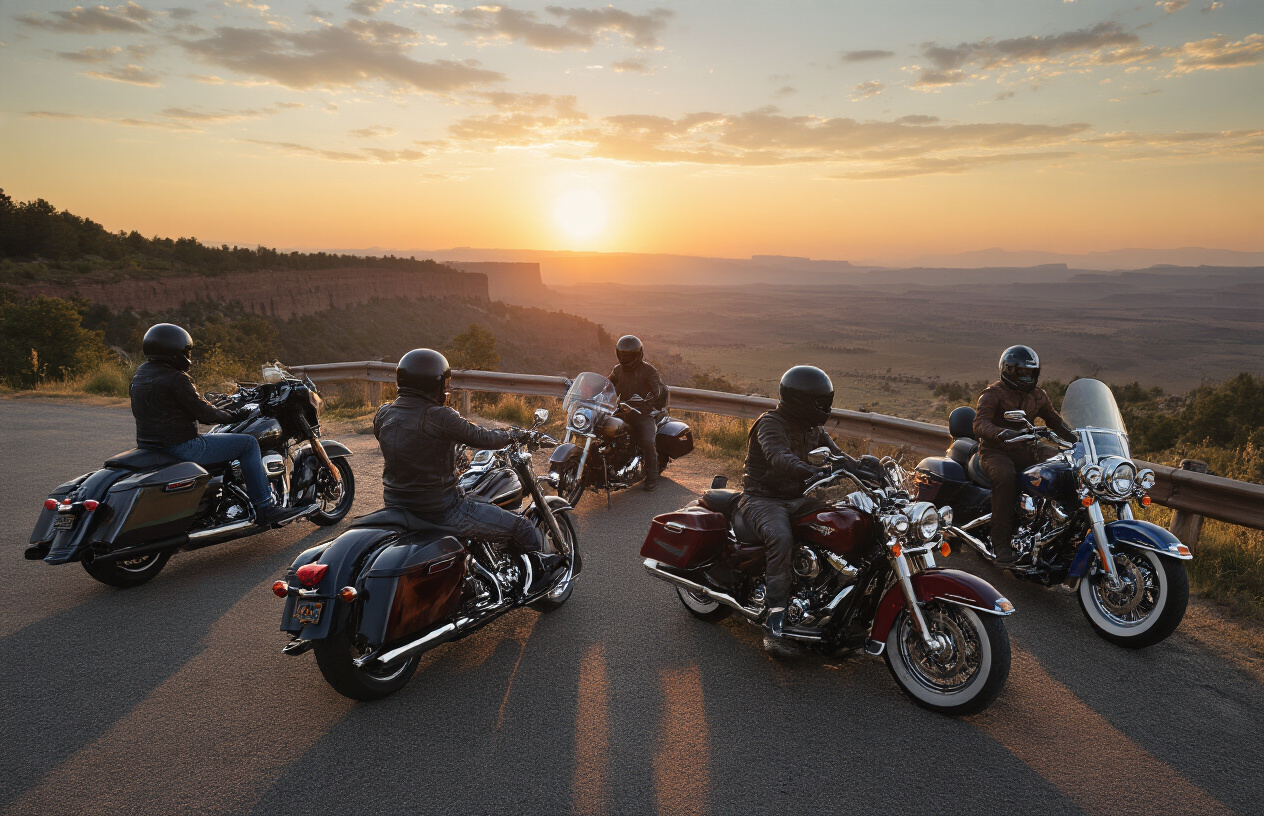
The American motorcycle landscape offers riders an impressive array of domestic brands that combine heritage, performance, and distinct personalities. From Harley-Davidson’s iconic status and unmistakable rumble to Indian Motorcycle’s rich history and competitive spirit, American manufacturers continue to capture the imagination of riders nationwide. Emerging brands like Victory and Buell demonstrate the resilience and innovation driving the industry forward, while the thriving custom culture provides endless possibilities for personalization.
When searching for your perfect American motorcycle, consider how each brand’s performance characteristics align with your riding style and preferences. Whether you’re drawn to Harley’s commanding road presence, Indian’s balance of tradition and technology, or the unique offerings from boutique manufacturers, today’s American motorcycle renaissance ensures there’s a perfect match waiting for every enthusiast. The road is calling—make your choice and become part of America’s continuing two-wheeled legacy.

